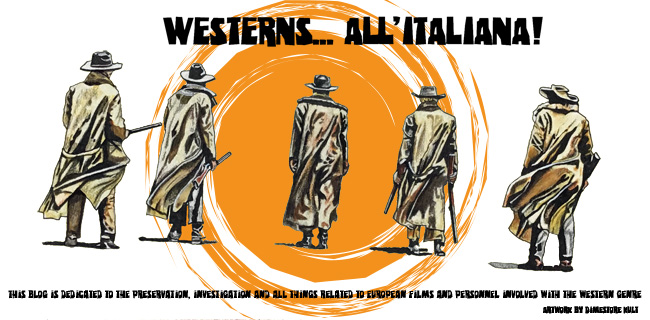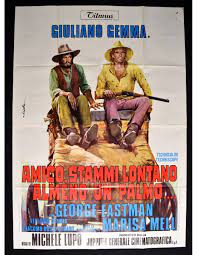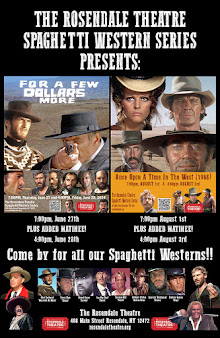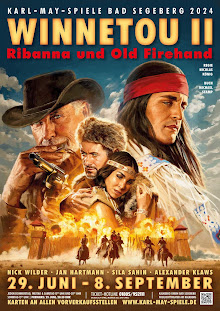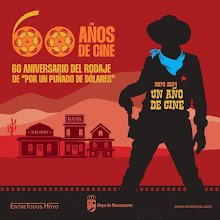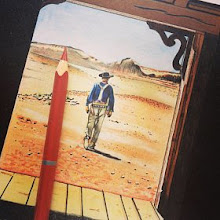
Today is the 50th anniversary of the premier
of “Shanghai Joe” directed by Mario Caino and starring Chen Lee, Gordon
Mitchell, Klaus Kinski and Robert Hundar. The story is a Shanghai Joe (Chen
Lee) who arrives in San Francisco, in 1882. He’s a Chinese skilled in the
martial arts, who goes in search of work. Self-confident, he applies for work
as a cowboy, at a ranch. He immediately learns about racial discrimination and
the ranch hands are determined to put the Chinaman in his place. Believing that
they can easily beat the skinny Chinaman they attack him and try to beat him
up, but Joe beats them using his special skills and is hired by Kay (Lorenzo
Fineschi), the foreman of Spencer (Piero Lulli), a wealthy businessman in the
area, to move his cattle herd to Mexico. But Joe soon discovers that instead of
cattle, they are smuggling Mexican workers. Stopped by the sheriff (Andrea
Aureli) and his men, the gunmen Kay quickly escapes and kills the peons. Joe
rebels against this injustice and helps an injured worker escape. Spencer, by
this time, considers him a traitor who must be eliminated with various gadgets
and ambushes he hires, Pedro the Cannibal (Robert Hundar), Scalper Jack (Klaus
Kinski) who fail in their mission to kill Joe. Mikuja (Katsutochi Mikuriya),
also a Chinese and educated by the master himself, the Venerable Yang (George
Wang), tackles Joe. But you cannot use Japanese martial arts to hurt another
martial arts expert and Joe triumphs in the end.
The film ranks 394 and brought in 109,980 lira at the box
office.
Il mio nome è Shangai Joe – Italian title
Mezzogiorno di fuoco per Han-Hao – Italian title
Meu Nome é Shangae Joe - Brazilian title
Shanghai Joe – Texas hernnaevne – Danish title
On m’appelle Shanghai Joe – French title
Shanghai Joe – French title
Der Mann mit der Kugelpeitsche – German title
Karate Jack - Ich bin euer Henker – German title
Mein Name ist Karate-Jack – German title
Knochenbrecher im wilden Westen – German title
I grothia tou Shangai Joe – Greek title
Monomahia me grothies kai karate – Greek title
T'onoma mou einai Shangai Joe – Greek title
Shanghai Joe – Greek title
荒野のドラゴン – Japanese title
Koya no Dragon – Japanese title
Mezzogiorno di fuoco per Han-Hao – Spanish title
Shangay’dan Gelen Adam – Turkish title
Benim Adim Shanghai Joe – Turkish title
The Man Strikes Back – U.K. title
My Name is Shanghai Joe – English title
To Kill or to Die – English title
The Fighting Fists of Shanghai Joe – English title
The Dragon Strikes Back – U.S.A. title
Shanghai Joe – U.S.A. title
A 1973 Italian film production [C.B.A. Produttori e
Distributor Associati, CCC (Rome)]
Producer: Renato Amgiolini, Roberto Bessi
Director: Mario Caiano
Story: Mario Caiano, Carlo Alberto Alfieri, T.F. Karter
(Fabrizio Trifone Trecca)
Screenplay: T.F. Karter (Fabrizio Trifone Trecca), Mario
Caiano
Cinematography: Guglielmo Mancori [Technicolor,
Techniscope]
Music: Bruno Nicolai
Running time: 100 minutes
Cast:
Chin Hau/Shanghai Joe – Chen Lee (Mioshini Hayakawa)
Scalper Jack – Klaus Kinski (Nikolaus Nakaszynski)
Pedro ‘The Cannibal’ – Robert Hundar (Claudio Undari)
Mikuja/Fire Lotus Warrior– Katsutochi Mikuriya
Buryin’ Sam – Gordon Mitchell (Charles Pendleton)
Kay – Lorenzo Fineschi
Christina – Carla Romanelli
Christina’s father - Francisco Sanz
Tricky – Giacomo Rossi Stuart
Tricky henchmen – Claudio Ruffini, Franco Ulmar
Master Yang – George Wang (Wang Yie)
Slim – Rick Boyd (Federico Boido)
Samuel/Stanley Spencer – Piero Lulli (Giusva Lulli)
Sheriff Andy Corrotto – Andrea Aureli
Jesus – Tito Garcia
Blacksmith – Vaerano Ginesi (Voriano Ginesi)
Bank employee - Vincenzo De Palo
Manuel Omero/Homer – Dante Cleri
Smitty – Roberto Dell’Acqua
Conchita – Carla Mancini
Conchita’s brother – Luciano Casamonica
Craig – Alfonso de la Vega
Tom - Franco Moruzzi
Poker players – Umberto D’Orsi
Doctor – Dante Maggio
False Teeth – Osiride Pevarello
One-eyed old man – Giovanni Sabbatini
Wells Fargo clients – Aldo Cecconi, Lars Bloch
Ferguson ranch foreman - Lorenzo Fineschi
Way station heckler – Giuseppe Mattei
Slave handler – Jose Luis Chinchilla
Kid in front of hotel – Juanito Santiago
Smitty – Roberto Dell’Acqua
‘False Teeth’ – Osiride Pevarello
Ferguaon ranch hands – Sergio Testori, Pietro Torrisi,
Sergio Ukmar, Sergio Ukmar,
Raniero Dorascenzi
Spencer’s guests – Enrico Marciani, Luigi Antonio Guerra
Stagecoach teller - Angelo Casadei
Stagecoach driver – Angelo Susani
With: Giorgio Bixio (Lazzaro Bisio)
